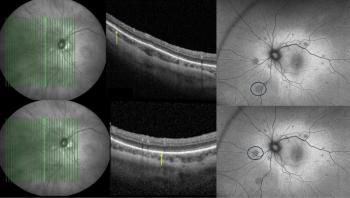
- Ophthalmology Times Europe April 2021
- Volume 17
- Issue 3
Small-aperture IOL yields high satisfaction in retrospective review
The IC-8 IOL uses the small-aperture concept to extend cataract patients’ depth of focus. Patients report high approval and reduced spectacle dependence.
The IC-8 IOL from AcuFocus harnesses the pinhole principle to extend cataract patients’ depth of focus. The lens has a centrally located, embedded polyvinylidene difluoride annular mask intended to improve near vision based on the small-aperture concept. It works by protecting central light rays and restricting peripheral light rays that may degrade image quality and range of focus.1-3
The size of the mask is optimised to provide excellent quality of vision with a modulation transfer function that is superior to that of other multifocal or extended depth-of-focus lenses, translating to reports of high patient satisfaction.
Whereas other technology requires more precision when it comes to hitting the targeted refractive aim, the IC-8 is forgiving to refractive error, tolerating up to 1.00 D spherical deviation and up to 1.50 D of corneal astigmatism.4-6
This degree of astigmatism tolerance is important, as we increasingly find biometric errors arising from preoperative dry eye and tear film irregularity.
In multiple studies, the lens has been found to provide excellent depth of focus for uncorrected near visual acuity and uncorrected intermediate visual acuity, compared with monofocal implants.1,7,8
Retrospective review
My colleagues and I undertook a multicentre, retrospective chart review of 126 consecutive patients implanted with the IC-8 at six Australian sites.
We evaluated patients’ visual acuity and satisfaction at their last visit (average 29 weeks ± 19.8, range 1–75 weeks; six patients did not attend the final visit).
The included patients had a cataract in at least one eye and a desire for reduced dependence on glasses. Patients were excluded if they had a pupil size > 6.0 mm or ocular pathology obscuring the central visual axis.
All patients received an IC-8 IOL in one eye, typically the nondominant eye. The IOL implanted in the fellow eye varied according to physician: 19 phakic lenses, 52 monofocal, 35 monofocal toric, 19 multifocal and one IC-8 IOL were used.
Monocularly, in the IC-8 eye, patients achieved a mean of 6/9 (J2) uncorrected visual acuity for all distances; binocularly, patients gained additional lines of acuity from near to far (see Figure 1).
Most patients achieved complete spectacle independence: 54% were spectacle independent at near and 91% were spectacle independent at far. The average satisfaction score (scale, 1–10) at the last postoperative visit was 8.1 for near vision and 9.1 for distance.
We also looked at outcomes in 17 patients with pre-existing ocular pathology. The IC-8 IOL was implanted in each patient’s worse eye; one patient with corneal scarring received the lenses bilaterally. A majority of these patients maintained or gained distance vision; all gained intermediate and near vision.
In this series of patients, the lens reliably extended depth of focus. Refractive error can be adjusted to address a patient’s visual needs, and the lens can be successfully paired with monofocal, toric and multifocal IOLs.
Patients with mesopic pupil size > 6.0 mm may experience dysphotopsias, to which patients typically adapt; however, they should be counselled or excluded from consideration. Patients implanted with this lens reported high satisfaction and reduced dependence on spectacles.
Conclusion
The lens offers greater spectacle independence for patients looking to achieve this, especially in outdoor tasks and without significant compromise in optical quality, coupled with few dysphotopic symptoms such as glare and halos. Patients are happy with the lens and even those with aberrated corneas can achieve good-quality outcomes.
This lens may play a therapeutic role in eyes with a variety of pre-existing ocular pathologies.9,10 The small aperture mitigates both higher and lower order aberrations in irregular corneas, making the lens a viable option for patients who previously had few options.
---
Brendan James Vote, MBBS
E: [email protected]
Prof. Vote is clinical professor in ophthalmology at the University of Tasmania and is in practice at the Launceston Eye Institute in Tasmania, Australia. He established the nonprofit Tasmanian Eye Institute in 2008 for Research, Education and Service (www.tasmanianeye.org.au). He has no financial disclosures to make.
References
- Grabner G, Ang RE, Vilupuru S. The small-aperture IC-8 intraocular lens: a new concept for added depth of focus in cataract patients. Am J Ophthalmol. 2015;160:1176-1184.
- Dick HB, Piovella M, Vukich J, et al. Prospective multicenter trial of a small-aperture intraocular lens in cataract surgery. J Cataract Refract Surg. 2017;43:956-968.
- Tucker J, Charman WN. The depth-of-focus of the human eye for Snellen letters. Am J Optom Physiol Opt. 1975;52:3-21.
- RE Ang. Small-aperture intraocular lens tolerance to induced astigmatism. Clin Ophthalmol. 2018;12:1659-1664.
- Braga-Mele R, Chang D, Dewey S, et al. Multifocal intraocular lenses: relative indications and contraindications for implantation. J Cataract Refract Surg. 2014;40:313–322.
- Ang RE. Visual performance of a small-aperture intraocular lens: first comparison of results after contralateral and bilateral implantation. J Refract Surg. 2020;36:12-19.
- Dick HB, Piovella M, Vukich J, et al. Prospective multicenter trial of a small-aperture intraocular lens in cataract surgery. J Cataract Refract Surg. 2017;43:956-968.
- Ong HS, Evans JR, Allan BD. Accommodative intraocular lens versus standard monofocal intraocular lens implantation in cataract surgery. Cochrane Database Syst Rev. 2014;5:CD009667.
- Shajari M, Mackert MJ, Langer J, et al. Visual performance of a small-aperture intraocular lens: first comparison of results after contralateral and bilateral implantation. J Cataract Refract Surg. 2020;46:188-192.
- Agarwal S, Thornell EM. Cataract surgery with a small-aperture intraocular lens after previous corneal refractive surgery; visual outcomes and spectacle independence. J Cataract Refract Surg. 2018;44:1150-1154.
Articles in this issue
over 4 years ago
Smartphone direct ophthalmoscope tech helps visualise optic discover 4 years ago
Visualisation with en-face OCT offers value for ophthalmologistsover 4 years ago
Study targets strategies for CI-DMOover 4 years ago
Is low vitamin D a risk factor for primary open angle glaucoma?almost 5 years ago
Investigators find genetic factors may influence diabetic eye diseaseNewsletter
Get the essential updates shaping the future of pharma manufacturing and compliance—subscribe today to Pharmaceutical Technology and never miss a breakthrough.













































